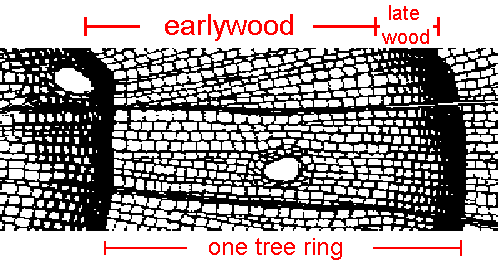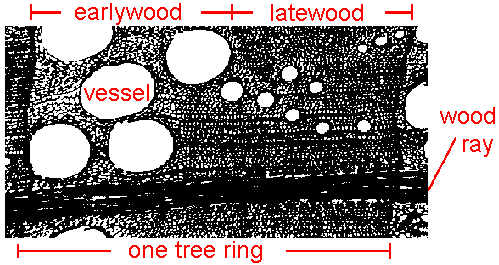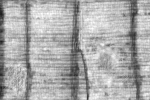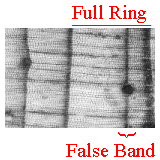
The Laboratory of Tree-Ring ResearchDendrochronology |
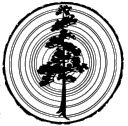 |
Dendrochronology is the dating and study of annual rings in trees:
- ology: the study of
- chronos: time, or more specifically events in past time
- dendros: using trees, or more specifically the growth rings of trees
Conifer Tree Ring
- Earlywood:
- Cells: thin walls, large diameter
- Appears light in color
- Latewood:
- Cells: thick walls, small diameter
- Appears dark in color
Ring Porous Angiosperm Tree Ring
- Earlywood:
- Cells: large diameter vessels
- Latewood:
- Cells: small diameter vessels
In the image below, a confier tree-ring sample shows about thirty rings (every tenth ring is marked) grown from left to right. The rings display much variation:
- Total ring width:
a light and a dark band
- Latewood width:
just the dark bands
- Latewood density:
darkness of dark bandVariation in these rings is due to variation in environmental conditions when they were formed. Thus, studying this variation leads to improved understanding of past environmental conditions and is the basis for many research applications of dendrochronology.
A key distinction of dendrochronology is that all trees rings being analyzed are dated to their correct year of formation. At first glance, it appears easy to date tree rings by just counting them, but reality is often more complicated than that:
Locally Absent Rings:
- Bottom part of this photo has 4 full rings
- Top part of this photo has only 3 full rings
- Wedging ring is "locally absent" from that part of the sample
- This sample is crossdateable, but not by mere ring counting
False Rings:
- This photo has 2 full rings -- right-most ring has a false band
- The false band appears to go through a resin duct
- This sample is crossdateable, but not by mere ring counting
Instead of merely counting rings, dendrochronologists crossdate tree rings :
- Match ring-growth characteristics across many samples from a homogeneous area
- Identify exact year of formation of each ring
- Among other methods of crossdating, one is to "skeleton plot" samples:
- Plotting variation on graph paper
- Matching similar variation on graph strips
- Try crossdating by skeleton plotting for yourself on the web
LTRR Home
Mission Statement
History of
LTRR Dendrochronology
Faculty and Staff
Research Teaching Outreach, Extension
Visiting
Scholars
Tree-Ring Talks
Graduate
Studies Personnel Directory
Software Related Links
The University of
Arizona
Laboratory of Tree-Ring Research, The University of Arizona
Tucson, Arizona 85721 USA
Main Office: (520) 621-1608, Fax: (520) 621-8229
Comments to Paul Sheppard: sheppard@ltrr.arizona.edu
Copyright © 1999, Laboratory of Tree-Ring
Research, The University of Arizona
Revised -- September, 1999
URL:
http://tree.ltrr.arizona.edu/dendrochronology.htm
